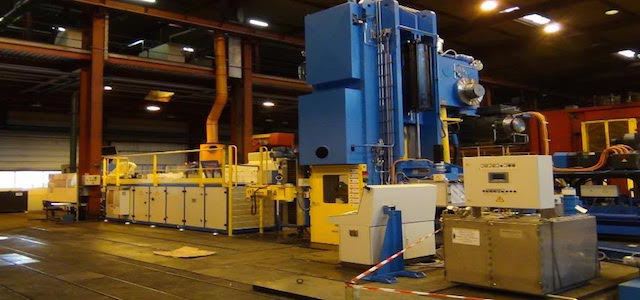
High-Quality Closed Die Forgings are Mainly Produced With Hammers, Mechanical, Hydraulic and Screw Presses
There is a variety of vertical forging presses dedicated mainly to the production of hot and warm closed die forgings with high stiffness. The choice of the press depends on the type of the desired final product (morphology and material) and on the planned production rates. Logically, in contrast to the high-speed horizontal forging presses, the ram of the vertical ones is moving in a vertical direction and is not connected to the slide to which the working tool is attached.

Mechanical Press 630T for Warm Forging
The Closed Die Forging Process – Essentials and Important Considerations
As mentioned above vertical forging presses are mainly deployed in the closed die forging manufacturing process where dies move towards each other and cover the workpiece in whole or in a part. The raw material is placed in the bottom die. The shape of the forging is incorporated in the top or bottom die as a negative image. The upper die is striking or pressing against the lower one and the so produced impact is making the raw material flow into the cavities of the required shape. However, the impression for the forging can be in either die or divided between a top and bottom die. Closed die forging delivers real 3D parts with very important variations in thickness and shape and excellent mechanical properties as connecting rod, crankshaft, hub and many others.
Advantages of Closed Die Forging:
- Fast material deformation into the desired shape;
- Net shape or near net shape parts;
- Tighter tolerances;
- Suitable for almost all the metal materials;
- Good surface finish;
- Less or no machining;
- Minimum waste;
- Superior mechanical properties;
- High production efficiencies;
- Suitable for high production runs.
An Overview of the 4 Main Closed Die Forging Presses
Closed die forgings are routinely produced on the following vertical forging machines: hydraulic presses, mechanical presses, screw presses and hammers. Even though hammers differ from presses in how they deform the raw material, their ram still moves in a vertical direction. Presses squeeze the metal between two dies and hammers deform it through repetitive strokes.
| Hydraulic press | Hammer | Mechanical press | Screw press | |
| Power range | Approx. 1000 T and up to 100,000 T | From 1000 to 140,000 kgm | From 300 T to 16,000 T | From 500 T to 18 000 T |
| Number of Workstations | 1 to 3 | 1 to 3 | Up to 5 | 1 or 2 |
| Forging Rate | Slow | Average | High | Average/High |
| Size of Production Batches | Suitable for small series; large series possible for small parts | Suitable for small and medium series; large series possible with robots | Suitable for big series; medium range possible with SMED | Medium and large series; (Robots and SMED recommendable) |
| Forging Speed | Average, but adjustable and programmable | Very fast (impact) | Fast but no impact | Very fast with an average impact |
| Adaptability to shapes and batch quantity | Good | Excellent | Good | Average |
| Adaptability to materials | Very good (all materials) | Good, but difficult on aluminum; nickel and some titanium based alloys are forbidden | Iron (suitable for small aluminum pieces) | Good (excellent for titanium based alloys and small pieces) |
| Production Constraints | It often requires the use of an ancillary press to shape a preform, or a process design with several reheating steps | The skills of forger are of critical importance; the training can last up to several years | Complex assembly and tooling; requires SMED robotic automation | Complex assembly and tooling. It is very often necessary to make a preform before forging on the screw press. ) |
| Investment Amount | High (high-speed pumps are expensive) | Moderate | Very high | High |
A Closer Analysis of the Comparison Parameters for Vertical Closed Die Forging Presses
Power Range
The power/strength range is indicated to present the maximum size of a forging machine – usually, the bigger the machine, the slower it is. Besides, the size and weight of the forged part depends on the machine’s size.
Number of Workstations
The number of workstations represents the number of dies, which can be set on the machine. A higher number of workstations contributes to the more progressive shaping of the slug, which allows more complexity and less die wear in the same heating phase.
Forging Rate
The forging rate indicates the number of parts produced per hour. Besides the heavy and slowly hydraulic press, all other mentioned vertical forging presses are relatively fast.
Production Volume and Forging Speed
SMED (Single-Minute Exchange of Die) can significantly speed up the forging process. The method facilitates the setting of dies and makes it possible to perform equipment setup and changeover operations in fewer than 10 minutes. Setforge possesses all necessary equipment to successfully deploy SMED and benefit from it.
Adaptability to Shape and Materials
The adaptability to various shapes and materials implies the ability of the forging machine to fulfill all metallurgical requirements as temperature control, deformation speed and many others.
Important Investment Considerations
The investment decision depends on the profile of the forging plant and is based on the following parameters: price, polyvalence and efficiency.
Conclusion
There are 4 important types of vertical forging machines: hydraulic presses, mechanical presses, screw presses and hammers.
The most powerful forging machine for large series is the mechanical press. It is the fastest and it can be easily automated. Since adapting the speed is not easy, mechanical presses are mostly suitable for steel than for other more sensitive materials as titanium or aluminum.
The screw press is almost as productive as the mechanical press. It is not as fast but it is much more suitable for the production of titanium parts, because of its fast speed and high impact.
The hydraulic press is the slowest and the less productive machine from all mentioned vertical presses. But, it is by far the most versatile one. Its forging speed is adjustable, it possesses a very good adaptability to different shapes and it is suitable for all materials. The hydraulic presses are largely used in the aerospace manufacturing.
The hammer is the most suitable machine for small series. It is also the machine with the best production volume/investment amount ratio. The hammer is much more flexible than a mechanical or a screw press because it allows the manufacture of parts that are larger than its size.
About Farinia Group
Setforge, the forging subsidiary of Farinia Group, consists of 9 sophisticated forging plants, equipped with state-of-the-art machinery. Dedicated to innovation and diversification, our service offer is continuously expanding to meet today’s requirements and deliver the best possible forged components, made of premium-quality raw materials.
